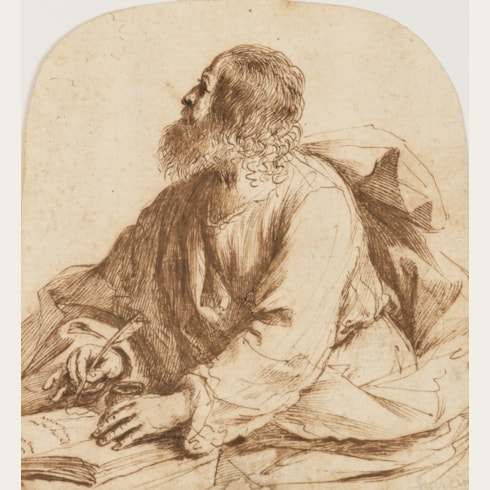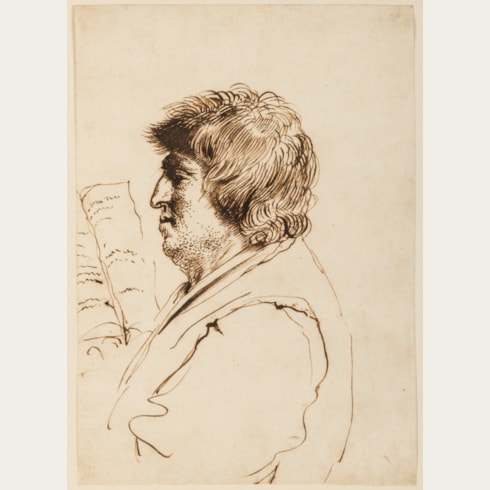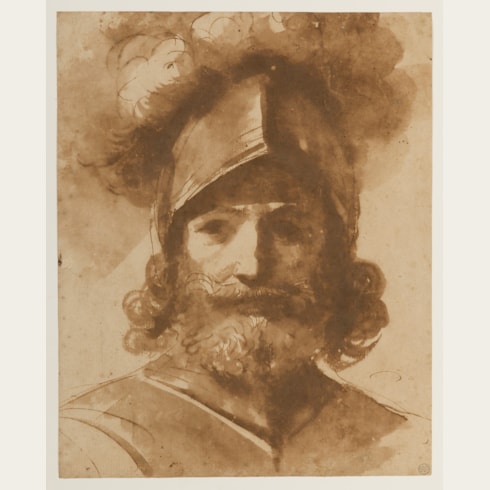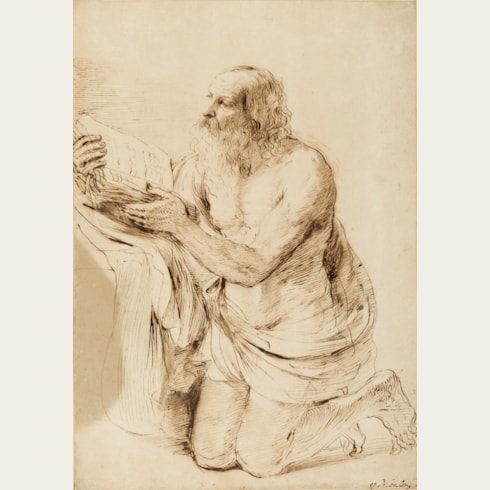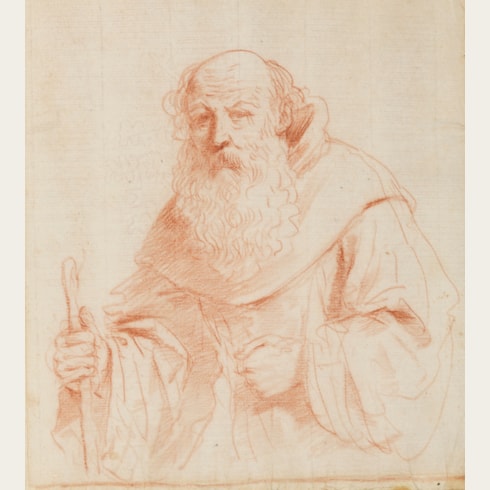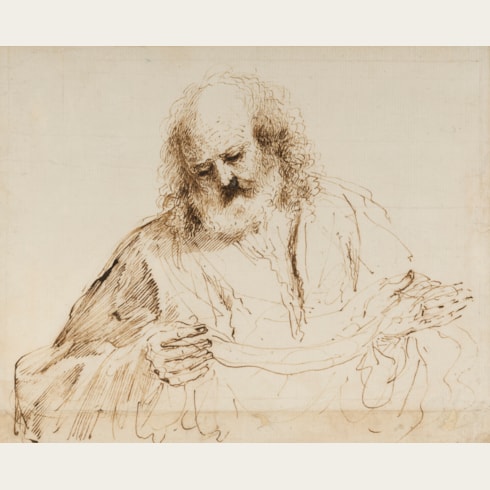Giovanni Francesco Barbieri GUERCINO
(Cento 1591 - Bologna 1666)
Charity [recto]; Landscape with Trees by a Farm and Figures by a Pond [verso]
The verso in pen and brown ink, lightly squared in red chalk.
Faintly inscribed CHARITAS on the scroll held by one of the children.
Further inscribed Guerchin at the lower right.
The verso faintly numbered 12 in the lower centre margin.
150 x 200 mm. (5 5/8 x 7 7/8 in.)
The verso of this drawing of Charity is notable as one of only a handful of landscape sketches by Guercino that can be approximately dated, by virtue of the compositional study of c.1625 on the recto. Because they are not related to his finished paintings, Guercino’s landscape drawings are difficult to accurately date, although most are assumed to date from the 1620s and 1630s, before he left rural Cento for Bologna. In fact, almost the only known securely datable landscape in his oeuvre is a drawing now in the Uffizi, which - according to an inscription on the sheet - was given by the artist in 1626 to Giovanni Battista Bandi, the governor of Cento. The use of diagonal squaring lines in red chalk in the centre of this early landscape composition is also unusual among Guercino’s drawings, as is the fact that the artist has drawn on both sides of a sheet of paper; indeed, very few landscape studies are found on the reverse of a figure drawing by the artist. (One such example is a double-sided drawing in the Princeton University Art Museum, which contains a landscape with trees and houses on the verso of a caricature study, from an album of caricature drawings by Guercino.)
As Nicholas Turner and Carol Plazzotta have written, ‘Guercino made numerous landscape drawings, yet the motivation behind this prolific output and its ultimate purpose remain obscure. Guercino rarely painted pure landscapes (though there are a few notable examples both in fresco and on canvas among his early works…), and usually the backgrounds of his history subjects are devoid of landscape details. It is therefore impossible to assign to any of these drawings a preparatory function. They were apparently made as ends in themselves, probably for the artist’s own personal satisfaction and for the amusement of his friends…The landscapes differ markedly from the artist’s working studies for history paintings in their meticulous execution, concern for detail, and highly finished appearance. Guercino nonetheless succeeded in achieving spectacular effects of light and space.’
According to the provenance given in the catalogue of the auction of William Bateson’s collection of drawings in 1929, the present sheet was once part of the collection of Italian drawings assembled in the last quarter of the 18th century by the English artist John Skippe (1742-1812). The drawing may have been acquired from one of Skippe’s descendants by the eminent biologist William Bateson FRS (1861-1926), who came to own a small but choice group of drawings by Guercino. The posthumous sale of Bateson’s collection, held in London in April 1929, included twenty-seven drawings by the artist, including this double-sided sheet.
Soon afterwards the present sheet entered the extensive collection of more than two hundred drawings by Guercino assembled by the American collector Dan Fellows Platt (1873-1938). Most, but not all, of Platt’s outstanding collection of Italian drawings – which included large groups of studies by Luca Cambiaso, Giambattista and Domenico Tiepolo and Salvator Rosa, as well as Guercino - were later presented to the Princeton University Art Museum. As this drawing does not appear in Mildred Lynes’s 1940 manuscript catalogue of the Guercino drawings in the Platt collection, it must have left his possession shortly after his death.
Giovanni Francesco Barbieri, known as Il Guercino (‘the squinter’) because he was cross-eyed, was by the second decade of the 17th century one of the leading painters in the province of Emilia. Born in Cento, a small town between Bologna and Ferrara, Guercino was largely self-taught, although his early work was strongly influenced by the paintings of Ludovico Carracci. In 1617 he was summoned to Bologna by Alessandro Ludovisi, the Cardinal Archbishop of Bologna, and there painted a number of important altarpieces, typified by the Saint William Receiving the Monastic Habit, painted in 1620 and now in the Pinacoteca Nazionale in Bologna. When Ludovisi was elected Pope Gregory XV in 1621, Guercino was summoned to Rome to work for the pontiff and his nephew, Cardinal Ludovico Ludovisi. It was in Rome that Guercino painted some of his most celebrated works, notably the ceiling fresco of Aurora in the Casino Ludovisi and the large altarpiece of The Burial and Reception into Heaven of Saint Petronilla for an altar in Saint Peter’s. The papacy of Gregory XV was short-lived, however, and on the death of the Pope in 1623 Guercino returned to his native Cento. He remained working in Cento for twenty years, though he continued to receive commissions from patrons throughout Italy and beyond, and turned down offers of employment at the royal courts in London and Paris. Following the death of Guido Reni in 1642, Guercino moved his studio to Bologna, where he received commissions for religious pictures of the sort that Reni had specialized in, and soon inherited his position as the leading painter in the city.
Guercino was among the most prolific draughtsmen of the 17th century in Italy, and his preferred medium was pen and brown ink, although he also worked in red chalk, black chalk, and charcoal. He appears to have assiduously kept his drawings throughout his long career, and to have only parted with a few of them. Indeed, more drawings by him survive today than by any other Italian artist of the period. On his death in 1666 all of the numerous surviving sheets in his studio passed to his nephews and heirs, the painters Benedetto and Cesare Gennari, known as the ‘Casa Gennari’.
The drawings of Guercino, which include figural and compositional studies, landscapes, caricatures and genre scenes, have always been coveted by later collectors and connoisseurs. Indeed, the 18th century amateur Pierre-Jean Mariette noted of the artist that ‘Ce peintre a outre cela une plume tout-à-faite séduisante’. The largest extant group of drawings by Guercino is today in the Royal Collection at Windsor Castle; these were acquired from the Gennari family by King George III’s librarian, Richard Dalton, between about 1758 and 1764.
Provenance
William Bateson, London and Merton House, Grantchester, nr. Cambridge (Lugt 2604a), his stamp on the verso
His posthumous sale, London, Sotheby’s, 23-24 April 1929, lot 48 (‘Charity. Pen and ink and brown wash. 6 in. by 7 7/8 in. (15 cm. by 20.1 cm.) A landscape with a cottage and trees on back. Collection: J. Skippe’, bt. Meatyard for £1)
Frederick Richard Meatyard, London
Probably E. Parsons and Sons, London
Dan Fellows Platt, Englewood, New Jersey, with both his collector’s mark (Lugt 2066b) and estate stamp (Lugt 750a) on the verso
By descent to his widow, Ethel Bliss Platt, Englewood, New Jersey
Mr. and Mrs. Gordon B. Washburn, Buffalo, New York
Michael Curran, Houston
His anonymous sale (‘The Property of a Gentleman’), New York, Christie’s, 11 January 1994, lot 202
Thomas Williams, London and W. M. Brady & Co., New York, in 1995
Private collection, Massachusetts.
Literature
Exhibition




















